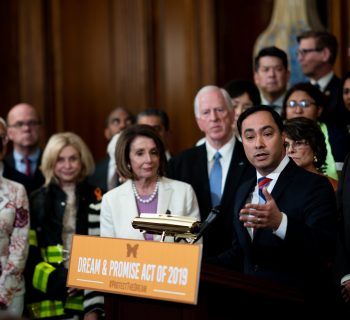America is actually becoming less competitive for immigrant workers. We need to address the very real economic challenges caused by slowing population growth.
By David Bier | USA Today | OCT. 3, 2023 | Photo by Stefani Reynolds
The Census Bureau this month published its most robust estimate of the U.S. immigrant population, and it casts doubt on a central Republican criticism of President Joe Biden: that immigration has spiraled out of his control on his watch.
In fact, the new data – analyzed by our team at the Cato Institute – indicate that the number of immigrants is still 2 million below the Census Bureau’s 2017 predictions. The hyperbolic rhetoric should take a backseat to the verifiable data.
Take Stephen Miller, former adviser to President Donald Trump. By July 2022, he had already announced that President Biden had “eradicated his own nation’s borders.”
Of course, this is a goofy conspiracy theory. Borders divide governmental jurisdictions, which it should go without saying haven’t changed, and they have nothing to do with the number of people who cross them. But the new Census data make this claim risible for another reason: The immigrant population had only risen marginally.
Immigrant share of U.S. population is just 13.9%
According to the American Community Survey (the Census Bureau’s annual mini-census), the immigrant share of the U.S. population rose just 0.3 percentage pointsbetween July 2021 and July 2022, reaching 13.9%.
If a shift of 0.3 percentage points can eradicate the United States as a country, the Trump administration must have left the United States in worse shape than anyone thought. Fortunately, it is the political rhetoric that is in worse shape, not the country.

The immigrant population did grow by nearly a million from July 2021 to July 2022. But consider the context. In 2017, the Census predicted that by last year, the immigrant population would have grown by 3.6 million. In reality, it grew 1.7 million – less than half the number the models predicted.
Just because the immigrant population isn’t shrinking like Miller wants doesn’t mean that America has ceased to exist.
Fix immigration loophole:I grew up an American – legally. Our broken immigration system forced me to deport.
On a longer timescale, it is apparent that the past decade has seen unusually slow growth in immigration. In fact, the period from 2012 to 2022 saw slower growth in the immigrant share of the population than the 2000s, 1990s, 1980s and 1970s. You have to go all the way back to the 1960s, when the immigrant population actually shrank, to find a lower growth rate.
Nor is America unusual compared with its peer nations. The United States also ranks in the bottom third of wealthy countries for its immigrant population share. America’s actually becoming less competitive for immigrant workers.
How worker shortage hurts the United States
The new Census data are much more important than other estimates of immigration. The American Community Survey collects information on a massive portion of the U.S. population, which prevents significant sampling errors, and it accounts not just for the number of immigrants coming in but also the numbers who are deported, leave on their own or die.
The new data dismantle the narrative that the United States is seeing an unprecedented surge in immigration. Moreover, as we face the lowest population growth in U.S. history, a decline largely attributed to Americans having fewer children, the immigrant share of the population should naturally have a larger impact. But even in these conditions, the immigrant share is growing at the slowest rate we've seen in a generation.
Of course, the number of immigrants has increased over the past year, too, but the new Census numbers show that we have plenty of room to grow.
US semiconductor production ramps up.But without STEM workforce, we'll lose the race.
Regardless, the broader concern isn't just about countering inflated rhetoric but addressing the very real economic challenges the United States faces due to slowing population growth. We're staring at a massive worker shortage, a precipitous drop in the worker-to-retiree ratio and a worrying exodus of skilled workers to nations like China.
The solution? We need people. We need workers across all skill levels to drive our economy, support our aging population and maintain our global competitive edge. Immigrants have historically played, and can continue to play, a crucial role in filling these gaps.
While it is natural to engage in debates about immigration policy and its implications, it is essential to root these discussions in fact rather than fiction. Instead of raising alarms over exaggerated claims of border erasure, our focus should be on crafting policies that align with our national interests, values and the reality reflected in the data.
After all, America thrives when it welcomes, integrates and capitalizes on the diverse skills and perspectives that immigrants bring to our shores.







